There is no network connection although the cable is connected. The network cable is not connected. What to do
What if the computer or laptop does not see the network cable and says that the network cable is not connected, although it is connected?
What if the network cable is not plugged in although it is plugged in?
AND network technologies have long been tightly entered into our lives. And if the Internet stops working, then for the majority it is a serious problem. This article will consider a situation in which the Internet and the local network do not work, and in the lower right corner of the monitor near the clock, a red cross icon with the inscription " Network cable not connected ”, although the cable is plugged into the computer's network card.
Possible causes of the "Network cable not connected" error when the cable is connected
This situation is possible for several reasons. Moreover, it can arise completely suddenly. The computer or laptop may not see the network cable because:
- There are problems on the side of your provider if the network cable comes directly to your computer without modems and routers;
- The network cable is damaged around the perimeter or poor contact at the end of the chip, which is inserted into the computer's network card;
- There is a problem with the drivers network card;
- The network card is not configured correctly;
- There are problems with the modem or router to which the network cable from the computer is connected.
How to fix the problem when the network cable is not connected even though it is connected?
So, the first thing to start solving this problem, this is to restart the modem or wi-fi router, after changing the port of the cable into which the wire from the computer is inserted to any other of the four available.
Changing ports on a modem or router
If the cable goes directly without modems and routers, then you need to call the support of your Internet provider and find out if they have any work on the line. which could provoke the problem of not connected network cable.
If this does not solve the problem and the computer still does not see the network cable, then it is worth getting the cable out of the network card connector and moving it at the junction with the transparent chip - the tip.

The network card connector in the computer
After that, try plugging the cable back into the computer and wiggling the end again, but without pulling it out of the computer.
When doing this, look at the computer monitor. If the connection appears when the cable is wiggled, then you have broken the cable crimping and you need to crimp it again with a transparent chip RJ-45.

Crimping internet cable RJ-45
If the above actions did not lead to any result, and the computer stopped seeing the network cable for no reason (before the problem occurred, reinstall windows replacing the motherboard or wifi router), then you need to localize the problem. To do this, you need 1 more computer or laptop with a working network connector.
Try plugging a cable into it and see if another computer can see it. If the situation has not changed and another laptop still says that the network cable is not connected, although it is connected, then there is a problem with the cable. It is damaged somewhere.
If another computer saw the cable, then there is a problem with your computer's network card or its settings.
You need to try to reinstall its driver, and also check that in the settings in the section Spped & Duplex(Speed and duplex) was set to " Auto«.
To check it, click right click mouse on the red cross with the inscription about the unconnected cable and select " Network and Sharing Center»
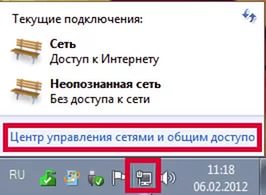
Logging into the Network and Sharing Center
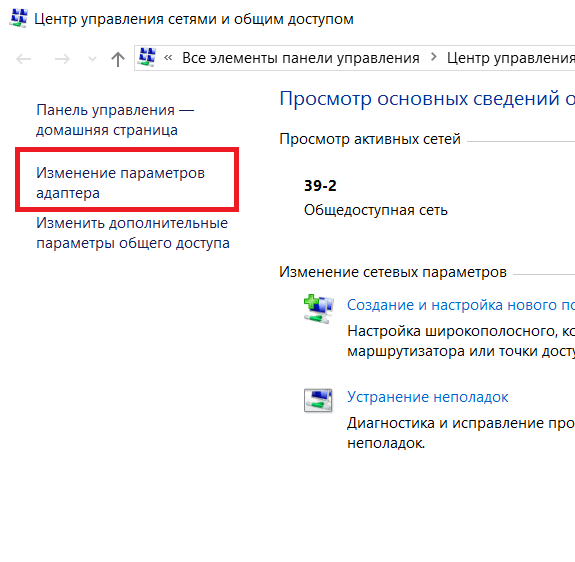
Go to the network cards of the computer

Choosing a wired network card
Now click on it twice with the left mouse button and select the button " Tune»Further tab« Additionally«.

Entering the network card settings
We are looking here Spped & Duplex(Speed and Duplex) and check its value on the right. Should be “ Auto«.
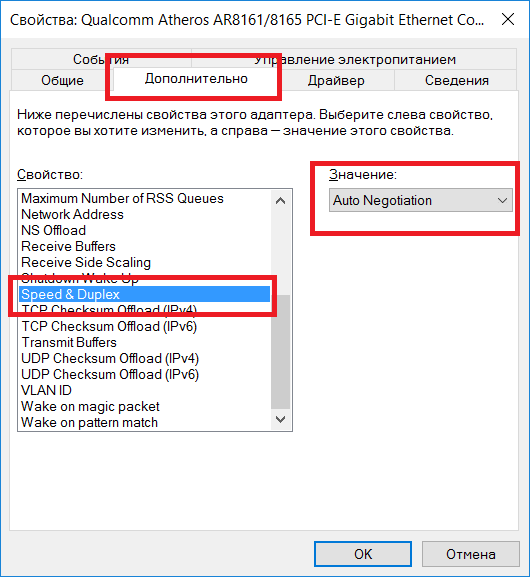
Checking the network card configuration
If all of the above did not help you, then you will have to change the network card to a new one.

Internet problems are something that everyone faces from time to time. Not infrequently, problems with the Internet are accompanied by a message that the network cable is not connected. In such situations, users ask a very reasonable question: who is to blame and what to do?
If you also faced a similar problem, then this material should help you. Now we will look at a number of reasons that can lead to this problem.
Reason # 1. Problems with the Internet provider.
If you see a message that the network cable is not connected, then don't panic. Most likely, your ISP is the cause of this error.
For example, the ISP may be doing repair work or something just broke. Call in technical support your ISP and report your Internet problems. If technical support says that they really are to blame, then you just have to wait until everything is fixed.
Reason # 2. Bad contact of the network cable.
If your Internet provider reported that everything is fine with them and everything is working, then you can start looking for the reason in yourself. First, check the contact between the cable and the port on the network card. To do this, disconnect and reconnect the network cable. At the moment of connection, you should hear a small click, indicating that the network cable is fixed in the connector.

Reason # 3. The network cable is damaged.
A fairly common cause of the "Network cable not connected" error is mechanical damage to the network cable. Examine the condition of the network cable from your computer to the ISP's dashboard. Pets could damage the cable. Also, not very neat builders, electricians or just neighbors often become the cause of damage.

Fortunately, fixing a damaged network cable is pretty straightforward. All you need to do is cut out the damaged section of the cable and twist the conductors.
Reason # 4. Bad connector.
If you checked all of the above, but still receive messages that the network cable is not connected, then the reason may be a faulty connector. If the network cable was not crimped too neatly, then over time, the contact in the connector could disappear. This problem can be corrected only by re-crimping the network cable. You can do this yourself or contact the technical support of your Internet provider.
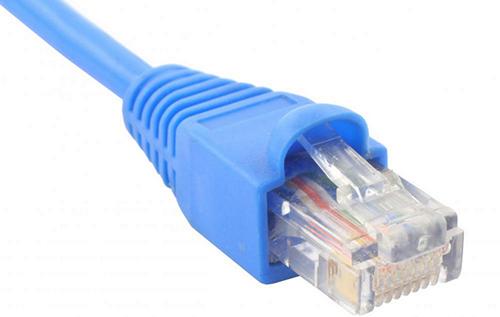
Reason number 5. Not working router.
If you connect to the Internet through your home router, then the router may be the cause of the messages about the unconnected network cable. In order to check this version, simply connect a network cable from your Internet provider directly to your computer. If the connection appears, then the router is really to blame.
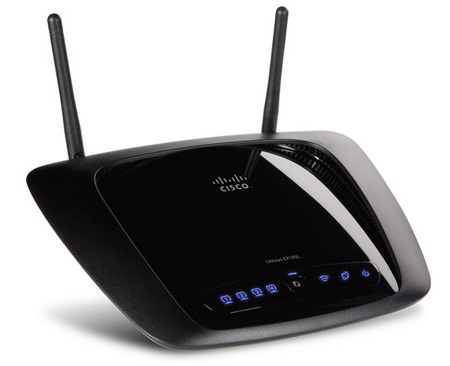
Reason number 6. Not working network card.
Failure of a network card is quite rare, but this possibility cannot be completely ruled out. To test this option, try connecting the network cable to another computer or laptop.
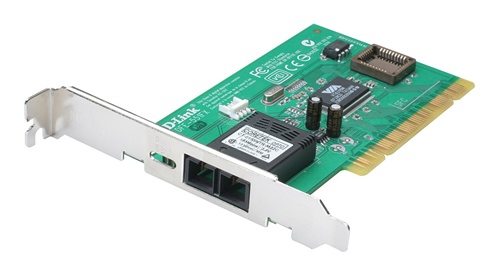
Configuring a network connection following all instructions is not a guarantee of uninterrupted Internet access. The reasons why the network stops working are varied and not always obvious. Let's talk about what can cause an Ethernet connection failure and how to fix it.

Why Windows 8 does not work with a network connection via a cable
Hardware reasons:
- damaged or poorly crimped network cable;
- the length of the cable segment between the network nodes is exceeded (more than 100 meters);
- network devices are not correctly wired;
- the network gateway (the device through which the computer connects to the Internet) does not work or is incorrectly configured;
- the cable is not connected to the network card of the computer;
- the network card is faulty or not installed (there is no driver);
- near a cable, computer or other network device(router, switch) there is a source of electromagnetic interference.
Reasons related to settings:
- network windows services;
- Changed the Winsock configuration (Winsock are Windows structures that control application access to network services);
- connection parameters are incorrect;
- the network adapter turns off to save energy;
- communication is blocked by incorrect settings of security software (firewall or Windows firewall);
- connection to the network (or only to the Internet) is limited by the administrator;
- Windows is infected malware that block access to the Internet.
If the connection is limited for individual applications, for example, only for the browser:
- the application connects to the Internet through a proxy server that is inaccessible;
- the application is blocked by the Windows firewall, firewall, or computer administrator;
- Malicious scripts are running in the context of the application.
We restore the work of the cable network
Fixing equipment problems
If the connection is completely absent, periodically disappears or loses data, start the test with a network cable. Make sure the insulation is intact and not kinked. Check the fastening of the connectors.

If you are setting up the connection for the first time, make sure that the cable is correctly crimped (the conductors are connected to the right contacts connector). Below are the crimp diagrams:
- to connect a computer to a device (switch or router);
- for a computer-to-computer connection.

Checking is relevant only when you crimped the cable yourself. Cables bought in a store already with connectors are rarely inoperative.
Next, check if the network is correctly connected. The connection to the Internet can be direct (the provider's cable is connected to the network card of the computer) or through a gateway (router or other computer). The method of switching and access settings can be found in the technical support of the provider.
When connecting via a router, it is important not to confuse the connection jacks: the provider's cable is inserted into the “INTERNET” or “WAN” jack, and the network cards of computers are connected to the “LAN” jacks.

If there is still no connection, check if the Windows network driver.
- Open the device manager - in Winows 8 it is called from the context menu of the Windows (Start) button.

- Expand the list " Network adapters”And check if there is an Ethernet card in it. If it is detected as an unknown device, go to its manufacturer's website using a different Internet connection, download and install the driver.

After that, open the properties of the map through the context menu in the device manager

and make sure it works fine.

Next, open the "Power Management" tab and uncheck the "Allow shutdown to save energy" item, otherwise the connection will be interrupted.

If after installation network driver connection is still limited, check if there are any interfering devices near the computer, router or network cable, such as cordless phones, high-power power lines, microwave ovens. Try to move your network equipment away from such places.
Checking Windows network settings
Using a network diagnostic tool
The "Troubleshooting" tool allows you to identify and eliminate the causes of various network failures in Winows 8. To start it, click on the "Network" icon in the system tray and select the item of the same name.

If the problem is not automatically corrected, the diagnostic tool will indicate what caused it.
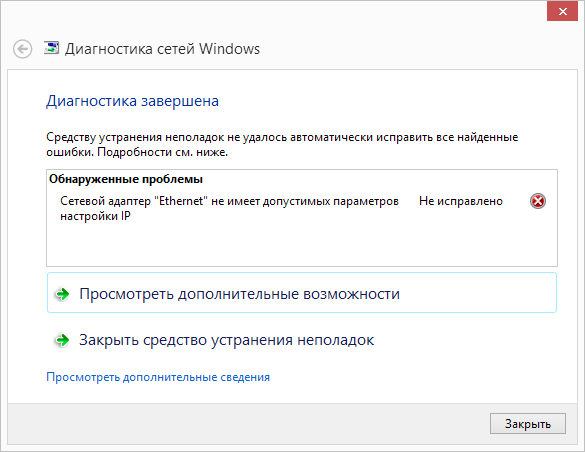
In this case, the cause will have to be looked for and corrected in other ways.
We start the services
The fact that the connection to the Internet is limited or absent is to blame for the failure of Windows network services. To test their work, open the service control application:
- v context menu Windows buttons(Start) click the "Run" item;

- enter the command in the "Open" field of the "Run" application services.msc and click OK. The application will launch.

In the service control program, verify that the following components are working:
- DHCP client;
- DNS client;
- Network Save Interface Service;
- Network configuration service.
If these Windows services are not running, the connection will not be created or will be limited to the local network only - without access to the Internet.
To configure autorun of network services together with Windows, open the properties of each of them (via the context menu).
If you look at the main topics of the forums where problems with the operation of local networks and the Internet are considered, then you can often come across the statement "the network cable is not connected, although it is connected" and the eternally accompanying questions "who is to blame?" and what to do next?".
This, in fact, is not a question, but a real cry for help. Believe it or not, the "network cable not plugged in" system message is familiar to many (if not all) users. The reasons for its occurrence are different, therefore, although sometimes the performance is restored by itself, in rare cases it is necessary not only to re-install operating system but also change the network card.
Connecting your computer to networks using Ethernet interface is currently one of the most popular. The advantages of this solution are obvious:
Availability. Chips of such network cards have been installed on their products by motherboard manufacturers for many years. Now there is no need, as before, to specially purchase a network card for
Reliability. No need for terminator plugs, precise matching and an improved software algorithm allow you to connect a 100 Mb / 1Gb cable to a network card even without special knowledge. In fact, a real Plug & Play.
 Why, with all these advantages, does the “network cable not plugged in” message lead users to search the forums for an answer? Is it really that complicated?
Why, with all these advantages, does the “network cable not plugged in” message lead users to search the forums for an answer? Is it really that complicated?
If you delve into the description of the details, it becomes clear that most often the "network cable is not connected" error occurs when using the Internet, and not local network consisting of several computers. That is, a "twisted pair" cable is removed from the owner of the computer and laid to the nearest selected Internet provider. This scheme increases the number of possible causes.
If the system says "network cable is not connected", it means that the data packets sent by the card do not reach the provider's network device. Thus, there are no acknowledgment reply packets. It is this circumstance that causes the message "network cable is not connected". The check should start from your own computer.  Let's describe the order of actions:
Let's describe the order of actions:
Control Panel - Network Control Center - Changes to adapter settings. Here, on the desired connection, press the right mouse button and select "Disconnect". After 5-10 seconds, turn everything back on in the same way.
We remove the plug of the wire from the connector of the network card. We wait a few seconds and reconnect it - sometimes the problem lies in poor contact and is thus eliminated.
Most often, the reason for inoperability is caused by service work on the provider's equipment (for example, they connect new subscribers or change the switch). At the same time, the power is temporarily turned off, as a result, the network does not work. You just need to wait or call support to find out.
It used to be a real scourge of providers working through twisted pair, there was a theft. Low voltage allowed to fearlessly cut out a piece of the cable line and quickly hide with it. Now, when reliable doors are installed on the entrance doors, this has become a rarity. Although it cannot be ruled out. With a short line length, you can inspect its condition yourself.
Sometimes the cable gets damaged in the apartment itself. Unsuccessfully moved furniture easily damages the conductors. It is necessary to check and eliminate the malfunction.
Finally, it is useful to set latest version network card driver.
Your Windows displays a message Network cable
not connected, although in fact the cable is connected to the computer's network card! What to do?!
By itself, a message "Network cable not connected"
on the indicator icon LAN connections appears in the system tray when the computer's network card “does not see” from the connection to the home router or provider's equipment - depending on how you have connected Internet.
There are usually three reasons:
1. damaged cable or poor contact in the connector.
2. failure of your equipment.
3. Problems with the provider's equipment.
The best way to start the test is to unplug the cable from the connector on the network card and then plug it back in.
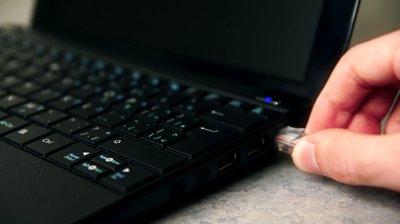
If your network uses ADSL modem, WiFi router or optical terminal ONT, and the computer is connected through it - disconnect the cable from the port of the router and turn it back on.
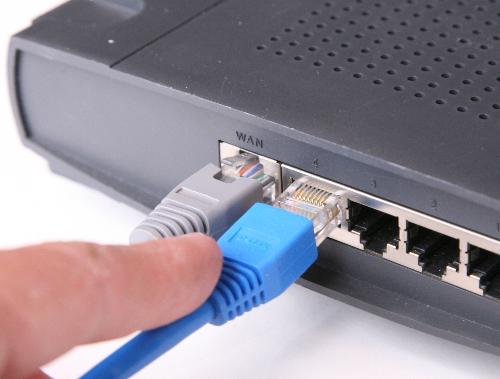
Look at the front of the router to see if the indicator of the connector where the computer is turned on is hot.
Did not help? We check the entire cable before entering the apartment for damage. If possible, check the cable wherever possible. Ideally up to the cable access box. If there is no damage, call the provider's technical support.
If it turns out that the equipment is in good order and the problem is not in it, you just have to try reinstall the network card
... To do this, press the key combination Win + R, in the opened window Execute writing a command devmgmt.msc and press the button OK... Will open device Manager
:

Find the section Network cards... In it we find the network card controller - the most common ones are Realtek, Nvidia, Atheros, Intel or Via... Right-click on it and select the item Delete... We reboot the computer.
After rebooting, the system will re-detect and install the network card drivers.
If all else fails ...
All that remains is to try another network card.

Perhaps your network card has taken a long time to live. In this case, if your network card is integrated into motherboard computer - try putting another one in the PCI slot.
 Bugs in Singularity?
Bugs in Singularity? Just Cause 2 crashes
Just Cause 2 crashes Terraria won't start, what should I do?
Terraria won't start, what should I do?